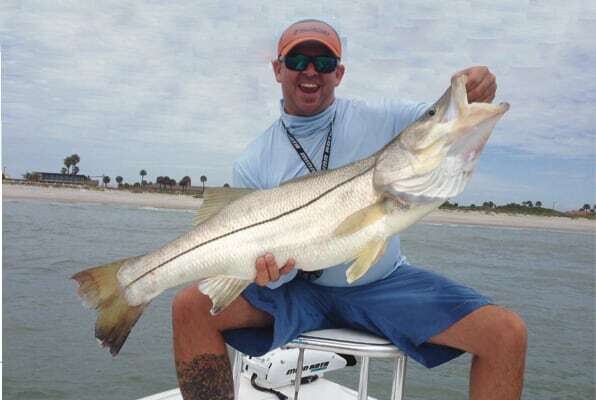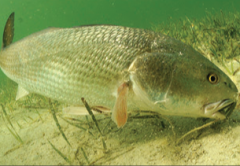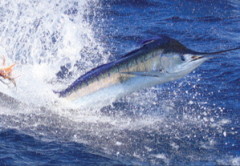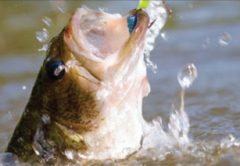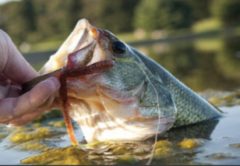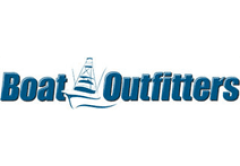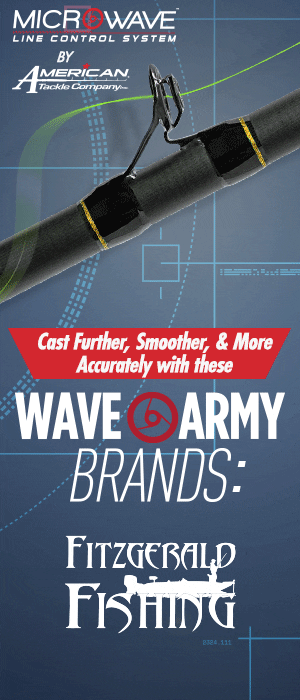Folks who are lucky enough to be in Central Florida during April and May – the time to catch an inshore slam is here. When stable weather and fishable breezes settle in, so do the species of game fish that three-species slams are famous for; tarpon, snook, redfish and spotted sea trout. Whether you are on the East or West Coast the time for catching a “Slam” is now. Our coastal waters warm and these game fish migrate closer to the inlets or passes from the rivers, creeks, back-waters, even deeper ocean waters. One thing for sure – they will be there. Not only will these hard fighting game fish be in these areas, at some time during the day with the right tide they are happy to eat live, cut, or artificial baits when properly presented.
Good reports of tarpon and snook have been coming from the East Coast, Port Canaveral south to Satellite Beach. The bait has arrived and has been south of the Cocoa Beach Pier down to the area just north of the Steeple, close or just behind the shore break. Once you find the pogies (Atlantic Menhaden Shad), one or two throws of the cast net and you will have plenty for a day’s fishing. Look for the birds diving or start near the bait schools looking for active predator fish. Hook your live bait through the bottom lip then out through the nose with a 7/0 to 9/0 circle hook with at least 50lb. leader and simply slow troll them keeping your eyes open for rolling tarpon or school fish feeding on the bait pods. Tarpon, snook, sharks, large jack crevalle and other species will be in the mix too. Large bull redfish and snook will be near the inlets and jetties and large sea trout in both the Banana and Indian River Lagoon systems.
West Coast destination – local waters of Charlotte Harbor and Pine Island Sound as well as the famous passes of Boca Grande, Captiva and Redfish Pass are some of the most famous locations
in the world for catching record game fish. Watching the sun break and rise above the eastern mainland take a boat ride across Pine Island Sound to catch a mixed well of live baits. Anglers not netting will be able to catch a nice trout while chumming and waiting for the bait to arrive. After you get a good slick going, a few throws of the 8ft. 3/8 mesh cast net will load your live well full of baits including pinfish, pigfish and white bait or greenbacks (scaled sardines). To complete a slam, anglers will usually move to the outside of Captive Pass. Set-up anchor about a mile off the island shore and wait with a few baits under a popping-cork and one or two others drifting on a free line. Keep your eyes open all the while for groups tarpon schools coming to the surface and gulping air. If the fish are off in the distance, pick- up and move the boat to get in the path of the on-coming school. As the fish move their way close, placing a good cast with a live bait or small pass crab in front of them will usually get a look from a fish in the passing school.
Fighting a tarpon of 100 to 200 pounds is much easier when in shallower water than those in the middle of Captiva or Boca Grande passes. Boca Grande is a very deep pass with hard running tides. The full-moon in the months of April and May will produce high flood tides bringing lots of bait and plenty of pass crabs on the out-going tides. When this happens late to early evening it is game-on! The Tarpon will stack in the pass and the chances of catching these trophies is as good as it gets, a Tarpon in the 150-to-200-pound class is the norm with fish well over 200 pounds not uncommon. Boca Grande Pass also holds huge Snook either just around the corner to the north at the old Phosphate docks or just to the south at the entrance to Pelican Bay. Snook in the 40-pound class can be found in these locations.
If you are looking to catch a slam of your own with tarpon, snook, redfish and trout – the feat can be accomplished in our Central Florida waters within a short drive of where you live. The month of April and May will be a great time to get out on the water and try your luck. Remember be safe, watch out for the late afternoon storms that approach rapidly and always wear an approved life vest while off-shore with your large outboard motor under power.


